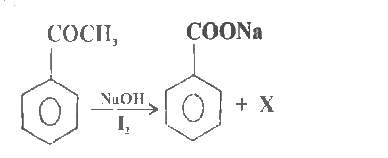Complete Solutions to QUESTIONS of chapter ALDEHYDES, KETONES AND CARBOXYLIC ACIDS of Class 12 book with complete answers and questions
| Class 12 | CHEMISTRY |
| Chapter | ALDEHYDES, KETONES AND CARBOXYLIC ACIDS |
| SUBHASH PUBLICATION | QUESTIONS |
| Number Of Questions | 70 |
| Academic Year | 2023-24 |
Mention the hybridised state of carbonyl carbon.
View SolutionGive the IUPAC name of `CH_(3)CHO`
View SolutionGive the IUPAC name of `CH_(2)=CH-CHO`.
View SolutionWrite the IUPAC name of `CH_(3)COCH_(2) CH_(2)CH_(3)`.
View SolutionExplain Rosenmund reduction of benzoyl chloride.
View Solution
Name the reaction.
View SolutionHow would you prepare acetaldehyde from acetyl chloride? Name the reaction.
View SolutionExplain Etards reaction.
View SolutionWhich oxidising agent is used in Etard reaction?
View Solution
Write the name of the above reaction.
View SolutionHow benzene is converted into benzaldehyde by Gattermann-Koch reaction?
View SolutionComplete the reaction

View SolutionHow ketone is obtained from Friedel craft's acylation reaction ?
View Solution
Write the structure of X in the above reaction.
View SolutionWrite the organic compound formed in the following reaction.

View SolutionExplain the mechanism of additon of HCN to a carbonyl group presence of a base.
View SolutionExplain the addition of ammonia and its derivatives with aldehydes and ketones.
View SolutionWhat happens when the carbonly compounds are treated with hydrazine? Write the reaction.
View SolutionComplete the reaction

View SolutionWrite the organic compound formed in the following reaction

View SolutionHow does propanone `(CH_(3)COCH_(3))` reacts with hydrazine? Give equation.
View SolutionMost of ketones does not give addition compound with sodium bisulphite. Give reason.
View SolutionGive reason : Acetophenone does not react with saturated sodium bisulphite solution.
View SolutionAldehydes are generally more reactive than ketones towards nucleophillic addition reactions. Give two reasons.
View SolutionName the reagent used in the conversion of ketone to hydrocarbon. Name the reaction.
View SolutionComplete and name the following reactions.
(a)
View SolutionExplain Wolff-Kishner reduction.
View SolutionWhat are P and Q?
View SolutionWhat is Tollen's reagent? How it reacts with aldehydes?
View SolutionWhat is Fehligns solution? How it reacts with aldehydes?
View SolutionExplain haloform reaction.
View SolutionExplain iodoform reaction.
View SolutionGive the IUPAC name of X.

View SolutionGive reason: `prop`- hydrogen atoms of aldehydes and ketones are acidic.
View SolutionExplain aldol condensation with an example.
View SolutionWhat is the action of dil. NaOH on ethanal (acetaldehyde)? Name the reaction.
View SolutionWrite the name of the reaction.

View SolutionWhat is cross aldol condensation. Give an example.
View SolutionHow does benzaldehyde reacts with acetophenone in presence of dilute alkali.
View SolutionEthanal`(CH_3CHO)` undergoes aldol condensation reaction.Give reason.
View SolutionExaplain Cannozzaro reaction with an example.
View SolutionIdentify A and B in the following reaction.

View SolutionAcetaldehyde does not undergo Cannizzaro reaction. Why ?
View SolutionFormaldehyde undergoes Cannizzaro's reaction. Give reason.
View SolutionGiven two uses of formaldehyde.
View SolutionHow are carboxylic acids prepared form Grignard regents ?
View SolutionWhat are Y and Z in the following reactions ?
View SolutionComplete the following reaction.
View SolutionComplete the following reaction.

View SolutionHow are carboxylic acids prepared from nitriles ?
View SolutionCarboxylic acids are more acidic than phenols. Give reason.
View SolutionExplain the effect of electron withdrawing groups. [EWG] on the acidity of carboxylic acids. Give examples.
View SolutionWhat is the effect of electron withdrawing group on the acidity of carboxylic acid ?
View SolutionExplain the effect of electron donating group (EDG) on the acidity of carboxylic acids. Give example.
View SolutionAmong formic acid and acetic acid, which is more acidic ? Give reason.
View SolutionHow `PCl_(3), PCl_(5) and SOCl_(2)` reacts with carboxylic acids ?
View SolutionWrite the chemical equation to convert ethanoic acid to ethanoic anhydride.
View SolutionThe equation for
The reaction between carboxylic acdis and `PCl_(5)`
View SolutionGive the equation for
The reaction between formaldehyde and con. KOH.
View SolutionGive the equation for
The formation of oxime from carbonyl compound.
View SolutionA carboxylic acid is heate with alcohol in presence of con. `H_(2)SO_(4)`. Name of the reaction Give its general equation.
View SolutionComplete the equation.
View SolutionHow carboxylic acids react with ammonia ?
View SolutionHow do you convert benzoic acid to benzamide ? Write the equation.
View SolutionWhat is the major product of the following reaction.

View SolutionExplain decarboxylation reaction with an example.
View SolutionWhat is soda lime ?
View SolutionExplain HVZ reaction with example.
View SolutionComplete the reaction
View SolutionComplete the equation
`CH_(3)COONa overset(NaOH+CaO)underset(Delta)to`
View Solution
QUESTIONS questions and complete solutions for chapter ALDEHYDES, KETONES AND CARBOXYLIC ACIDS of JEEVITH PUBLICATIONS CHEMISTRY (KANNADA ENGLISH) of Class 12